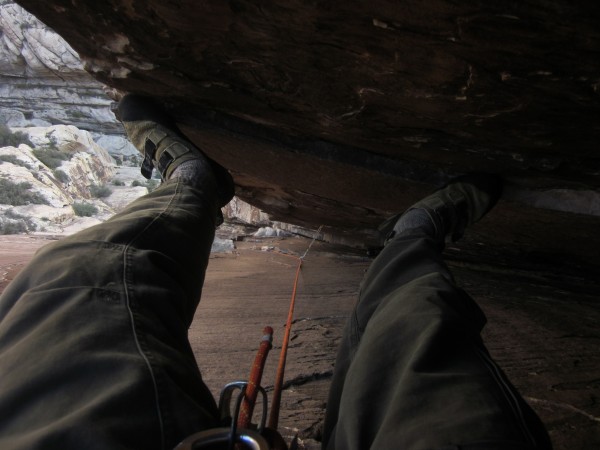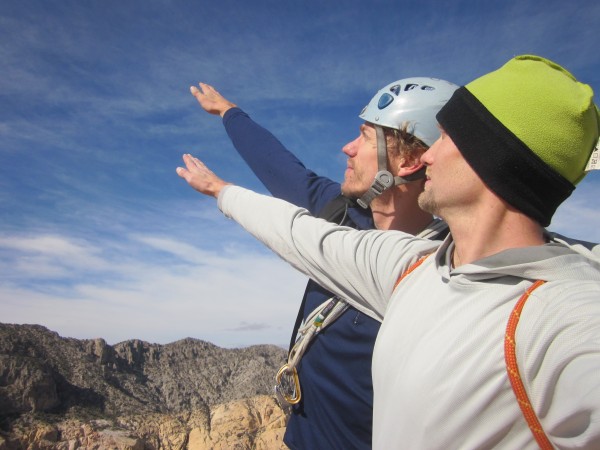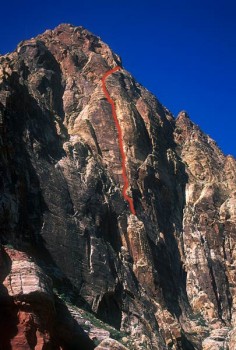We have all climbed routes in various styles. And the most fulfilling style is indeed usually onsight, with its element of uncertainty. It's harder, to be sure, but if enjoyment and satisfaction are the goals, this way of climbing--a true onsight, not a beta flash-- gives you more. The less you know beforehand, the better the climb is. And the more fulfilling it is if you can actually climb it.
Last weekend (Nov 19) Andre and I climbed Epinephrine, one of the longest and most famous routes at Red Rocks, 2300' of climbing (16-20+ pitches depending on the guidebook). Epinephrine's chimneys make it famous but its upper pitches are also fine with incredible position looking out at the spectacular Red Rocks nature and down into the canyon (and climbers on smaller routes) below. The climb ends at the summit of Black Velvet Peak, making a very nice climb even nicer by topping out on a high point. As Peter Croft said, summits matter.
While there is a lot of hype about the length of the climb (the guidebook mentions many parties have epics or overnights on the route), all pitches are very moderate and like many Pullharder climbers before me, Andre and I finished the whole climb quickly, in under 5 hours. At the summit just after 11am, we wondered if there was something else to do.
We descended from the peak, discussing our options. Go for a run? Sport climb with alpine draws? Find another multipitch climb nearby? We didn't want to go back to the car, we had some food and water so... let's climb some other long route!
But the guidebook was in the car. We searched the bags of other climbers at the base of the buttress, but no one had a guidebook in there. Curses! What to climb?
We were standing under Whiskey Peak, a subpeak of Black Velvet Peak and home to the very classic moderate route Frogland, which had several parties on it. There was a nice crack going up not far from Frogland. And another above it. We decided to just go up without any beta. We climbed those two pitches--they must have certainly been climbed before, as they were nice cracks.
Then, the obvious section ended. We were looking up at 500' more of rock to the top of the peak and no chalk marks, anchors or anything around. The terrain looked easy (5.8ish) heading up to some harder steep sections higher. Could we be doing a first ascent?
Holds broke often (though no falls) and the rock quality seemed very untouched--loose and licheny. We headed for the steepest way up the buttress (even overhung in several places) and were rewarded with a path that allowed our passage. It was zany and wild with some improbable looking sections, but not difficult once we got up close and were able to see small holds and cracks allowing us to climb safely. We topped out the buttress 2.5 hours after we started. A thrilling climb on new territory, following nothing but our instincts for where to go. So freeing!
We were back to the car well before sunset with 3000' of climbing for the day. We looked in the (1995) guidebook and our route was not in there. Then, we met back up with Leah in town, who had the newer guidebook. Our route was first climbed in 2005, Bourbon Street, 5.8+ (almost every pitch exactly like we did it).
It wasn't a first ascent. But our lack of beta made it as if it were. For us, this experience was the enjoyment, not our names in print in the guide. Six years ago it would have been a first ascent. But to this day, any route you spy on your own and go climb has the element of uncertainty and uncharted territory that makes the feeling of a first ascent so great.
Most everything in popular areas has been climbed, the the odds of lucking into a first ascent are small. But if you don't know it was climbed, you can still get the same satisfaction the first ascencionists did (and have to deal with less loose rock even!)
We had just climbed Epinephrine, a much more classic, longer, harder and better climb. It was also an onsight (or technically a flash for the pitches Andre led) and it was a great experience. But going up and indeed truly onsighting Bourbon Street without any beta, thinking it might be a first ascent, was more fun. Onsight here wasn't just about getting the climb clean. It was not being sure whether it would go or not, or whether we would be stopped by a blank unclimbable wall and have to turn around or bail to Frogland next door.
It's a bonus that there is some extra prestige tied to an onsight ascent. But even if you don't onsight the route, but still climb it without any beta (most notably not knowing whether or not it is a actually route) the adventure and satisfaction is still there. The more you know about the climb, the more mechanical and less fun it is. You can climb harder climbs, which is nice. But ultimately, those are not the most fun days you can have in the mountains.
Recently I began climbing without chalk on moderate and alpine routes. And with less pieces of gear. Less food, less water. Going lighter, as minimal as possible. Trying to climb with as little beta as possible. Trying to follow the line as naturally as it goes instead of looking at the topo midpitch every time. And my climbs have become successively more enjoyable, with the focus on the climbing instead of the details.
So put away those guidebooks. Look for a natural line up the wall, and go for it!







